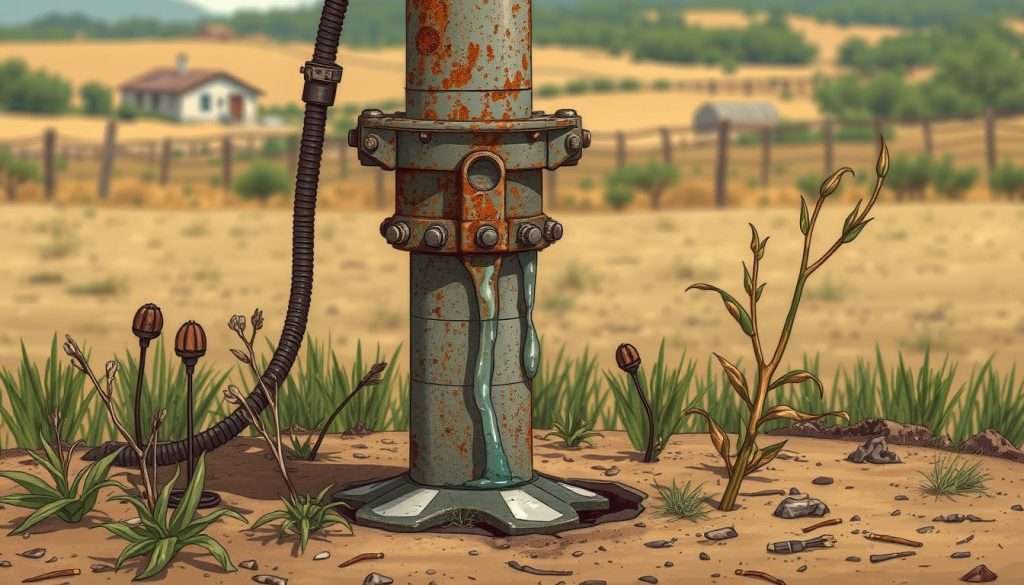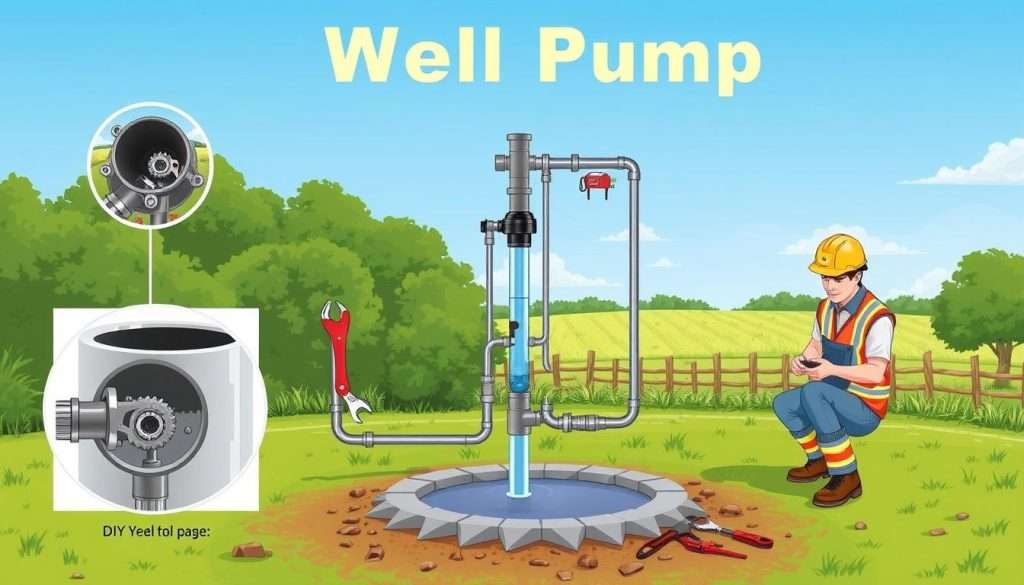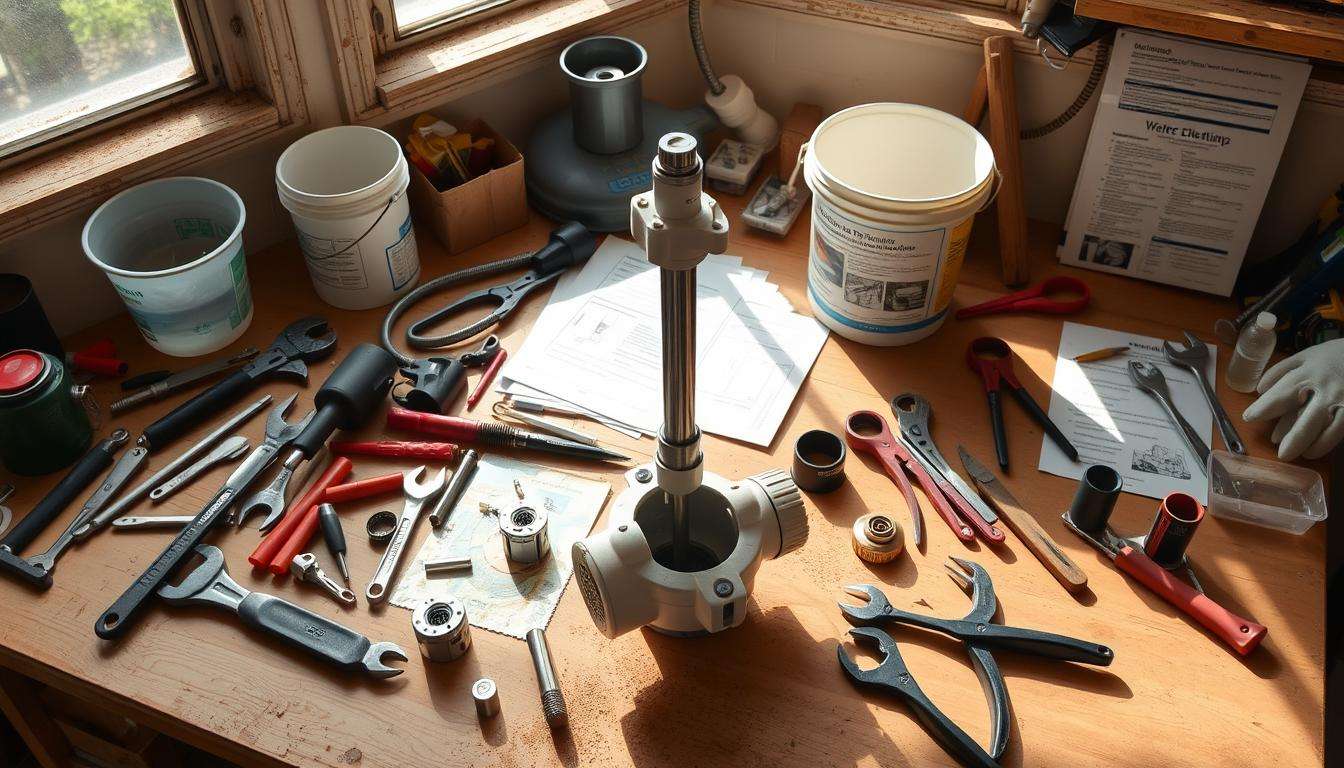Replacing a well pump might seem hard, but you can do it with the right tools and knowledge. A well pump brings water from the ground to your home. If it breaks or stops working, you might need a new one. We’ll show you how to do it step by step, saving you time and money.
Key Takeaways
- A 6″ diameter casing simplifies DIY well pump replacement.
- Wells can vary in depth; deeper wells should be handled by professionals.
- Regular sediment buildup can affect older wells, leading to pump issues.
- Using a pressure tank helps maintain consistent water pressure and saves electricity.
- Always check the connections and tools required before starting any pump replacement.
- Test the new pump thoroughly to ensure efficient operation after installation.
Understanding the Well Pump System
Knowing how a well pump system works is key to having water at home. A well pump pulls water from underground for us to use. There are many types of well pumps for different needs and depths.
What is a Well Pump?
A well pump is vital for getting water from deep underground to your house. It’s important to know what is a well pump. The pump makes pressure to move water from deep underground to tanks and taps for us to use.
Types of Well Pumps
There are many types of well pumps for different needs. The main types are:
- Submersible Pumps: These go underwater in the well. They push water up to the surface well.
- Jet Pumps: These sit above ground. They use suction for shallower wells. They’re good for not-so-deep wells.
How Well Pumps Operate
To understand how well pumps operate, think about how they work. Submersible pumps start when water level and pressure change. As water is used, the pump kicks in to keep the pressure right for your home.
Choosing the right pump depends on your well’s depth and water flow. The right size and care will keep your pump working well for years.
For help with installing, check out steps on well pump installation. They focus on safety and the tools you need.
| Well Pump Type | Typical Depth | Water Capacity | Common Uses |
|---|---|---|---|
| Submersible Pump | Deep Wells (greater than 25 ft) | Up to 20+ gpm | Residential and Agricultural |
| Jet Pump | Shallow Wells (less than 25 ft) | Up to 10 gpm | Home Water Systems |
Signs Your Well Pump Needs Replacement
Knowing signs of a failing well pump is key to keeping your water flowing. Spotting these signs early can stop big problems and save money. Look out for low water pressure, odd noises, and the pump turning on and off a lot.
Low Water Pressure
Low water pressure is a big clue something’s wrong. It could be dirt in the pipes or old parts in the pump. If your faucets don’t give enough water, it might mean you need to check the pump.
Strange Noises
Pumps usually don’t make much noise. But if you hear grinding or rattling, it’s a sign of trouble. These sounds mean you should check the pump right away, as they often mean a bigger problem is coming.
Frequent Cycling
When the pump turns on and off a lot, it’s a bad sign. This usually means the pressure switch isn’t working right. If the pump runs all the time or turns on by itself, you need to act fast to find and fix the problem.

Preparing for the Replacement Process
Before starting the well pump replacement, get ready well. You need to gather tools, follow safety rules, and empty the well. These steps make the installation easier.
Gather Necessary Tools and Materials
It’s key to have the right tools for well pump installation. Here’s what you’ll need:
- Plumber’s wrench
- Screwdriver
- Teflon tape
- Pitless adapter wrench
- Bucket or hose for drainage
Safety Precautions
Remember, safety precautions for well pump replacement are very important. Keep safe by following these tips:
- Turn off the power to the pump at the breaker box to avoid electrocution.
- Wear gloves to protect your hands from sharp objects and contaminants.
- Ensure that you have a partner to assist with pulling the pump, especially for deeper installations.
Draining the Well System
Draining the well system is key to safety. Here’s how to do it:
- Open a faucet inside your home to release any remaining water.
- Allow the water to flow until only a trickle remains.
- Close the faucet once the draining process is complete.
By following these steps, you’ll set up for a good installation. Proper preparation helps avoid problems during the replacement.

| Tool/Material | Purpose |
|---|---|
| Plumber’s wrench | Helps loosen and tighten various fittings and connections. |
| Screwdriver | Used for removing and securing covers and connections. |
| Teflon tape | Seals threaded connections to prevent leaks. |
| Pitless adapter wrench | Facilitates the removal of the pitless adapter in deep well systems. |
| Bucket or hose | Used for transporting drained water away from the work area. |
Step-by-Step Guide to Replacing a Well Pump
Replacing a well pump can seem hard. But, breaking it down into simple steps makes it easier. Follow these steps to disconnect the old pump, install the new one, and test it.
Disconnecting the Old Pump
First, turn off the power to the well pump. Make sure it’s safe by draining the system. Then, follow these steps:
- Shut off the power supply at the circuit breaker.
- Drain the well system to remove any remaining water.
- Remove the inlet and outlet ports carefully.
- Unscrew the electrical wires connected to the pump.
- Gently pull the old pump out of the well.
Installing the New Pump
Choose a new pump from a top well pump brand. Make sure it fits your well’s depth and follows the manufacturer’s guide. Key steps include:
- Apply Teflon tape to the threads on the pipes to prevent leaks.
- Install a pressure tank for consistent water pressure and to reduce wear on the pump motor.
- Consider installing a one-way check valve to prevent backflow of water.
Testing the New Pump
After installing the new pump, test it well. This means:
- Restoring power to the pump.
- Checking for proper water flow and pressure.
- Listening for any unusual noises that might indicate a problem.
By following these steps and using a well pump repair guide, you’ll keep your pump system working well.
Maintenance Tips for Longevity
Keeping your well pump in good shape is very important. It helps it last longer and work better. By following some well pump maintenance tips, you can spot problems early. This way, you can fix them before they get worse.
Check the electrical connections and seals around the pump often. Try to do a full check-up at least once a year. This helps avoid sudden breakdowns.
Regular Inspections
Watch for signs of wear in your well pump. These signs include low water pressure, strange sounds, and odd cycling patterns. By getting regular maintenance, you might avoid expensive fixes.
A professional will inspect, clean, and test the water quality. This keeps your system running smoothly. Companies like Well Doctor LLC offer help and support when you need it.
Seasonal Checks
Don’t forget about seasonal checks, especially in cold areas. Freezing weather can harm your pump if it’s not ready. Look for wear signs and take steps to protect it, like using a water level sensor.
Signs of Wear to Watch For
When you check your pump, look for rust or odd pressure readings. Finding problems early helps avoid bigger issues. It also makes your water flow better.
To learn more about keeping your pump running well, visit this resource. Following these tips can make your pump last up to 50% longer. This can save you a lot of money over time.
